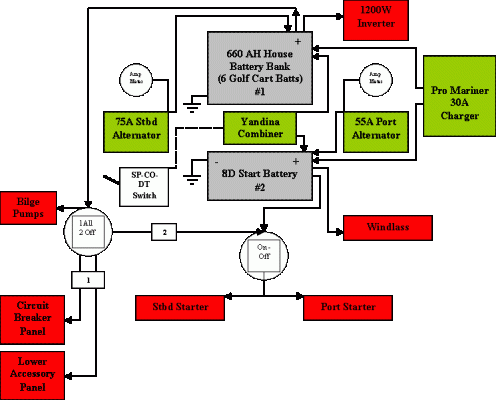4mo
Veteran Member
Hi all,
I bought a new to me 1996 Carver 370 Voyager last fall and have been having a blast on it this summer with my family in the San Juan and gulf islands.
First off thanks! This forum has been super helpful and I searched the forum for this but didn't see anything specific, so....
The bank that came with my boat is 4 group 27's in two banks. I kept the switch on 'all' this summer (400Ah) and ran down the batteries a few times overnight. I have since installed a monitor to help with that but also am upgrading the bank as well so I don't have to run the genny as much on the hook, where we like to be. My generator has its own start battery so I'm not sure on the need for a separate starter bank. (thoughts?) I also have gas Crusader 454 XL engines and I'm not sure if I need higher cranking batteries to start those or if GC2s would be okay.
Option 1: keep 2 group 27s and add a bank of 4 GC2s. This would have a starting bank and a house bank (420Ah). This wouldn't increase the size of my usable bank much as I'm under the impression that I would want to use these as two banks, not put the switch to 'all' except when the alternator or generator is charging them. Is that correct? Could I use them on 'all' and have a 620 AH bank?
Option 2: Replace the other 2 group 27s with 2 more GC2's and have a total of 6 GC2's all together and keep the switch on 'all' for 630Ah.
Option 3: I might be able to squeeze in 8 GC2s. This would necessitate a little more fiddling, and twice the cost but then I could leave them as one larger bank with the 'all' switch and have an 840Ah bank. Would this be an issue starting the motor vs. the duel purpose group 27's?
Thanks in advance for the experience and expertise!
I bought a new to me 1996 Carver 370 Voyager last fall and have been having a blast on it this summer with my family in the San Juan and gulf islands.
First off thanks! This forum has been super helpful and I searched the forum for this but didn't see anything specific, so....
The bank that came with my boat is 4 group 27's in two banks. I kept the switch on 'all' this summer (400Ah) and ran down the batteries a few times overnight. I have since installed a monitor to help with that but also am upgrading the bank as well so I don't have to run the genny as much on the hook, where we like to be. My generator has its own start battery so I'm not sure on the need for a separate starter bank. (thoughts?) I also have gas Crusader 454 XL engines and I'm not sure if I need higher cranking batteries to start those or if GC2s would be okay.
Option 1: keep 2 group 27s and add a bank of 4 GC2s. This would have a starting bank and a house bank (420Ah). This wouldn't increase the size of my usable bank much as I'm under the impression that I would want to use these as two banks, not put the switch to 'all' except when the alternator or generator is charging them. Is that correct? Could I use them on 'all' and have a 620 AH bank?
Option 2: Replace the other 2 group 27s with 2 more GC2's and have a total of 6 GC2's all together and keep the switch on 'all' for 630Ah.
Option 3: I might be able to squeeze in 8 GC2s. This would necessitate a little more fiddling, and twice the cost but then I could leave them as one larger bank with the 'all' switch and have an 840Ah bank. Would this be an issue starting the motor vs. the duel purpose group 27's?
Thanks in advance for the experience and expertise!




